By Elizabeth Flux, Andrew Fuhrmann, Jess Zanoni, Martin Boulton, Tony Way and Jessica Nicholas
This wrap of shows around Melbourne includes Niran Dasika and Sumire Kuribayashi performing together again, Noël! Noël!, a very-Melbourne spin on A Christmas Carol, Paul Kelly’s now-traditional Making Gravy concert, a deliciously unsettling night of dance, expertly controlled mayhem by King Gizzard and the Lizard Wizard, Australian Chamber Choir taking on Benjamin Britten, the MSO conducted by Sir Andrew Davis, and a fresh performance by legendary jazz band Morgana.
JAZZ
Niran Dasika and Sumire Kuribayashi ★★★★½
The Jazzlab, December 18
Niran Dasika’s sublime duo concert with Japanese pianist Sumire Kuribayashi at the 2018 Wangaratta Jazz Festival was one of my musical highlights of that year. So it was a delight to see these musicians reunited on Sunday night, closing out the Melbourne Jazz Co-op’s concert series for 2022.
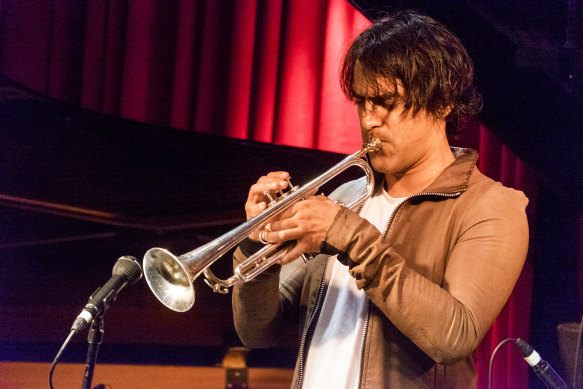
Niran Dasika performing at The Jazzlab, Decembe r2022. Credit: Roger Mitchell
Dasika first connected with Kuribayashi while living in Japan in 2016-2017, and though it’s been three years since they last performed together (with Dasika now back in Australia), it’s clear these two young artists are still deeply attuned to each other’s creative senses. As players and composers, both produce music that gleams with exquisite beauty, but can also radiate passion and dramatic intent.
Sunday’s opening set drew from the pair’s duo album Kiri, featuring compositions inspired by Japanese paintings. The level of trust the musicians have developed allowed them to roam freely in and around the evocative themes: propelling themselves forward on cascades of notes or pulling back to near-stillness, with Dasika’s plaintive trumpet hovering over Kuribayashi’s delicate pinpricks at the piano.
We also heard two poignant tunes by Kuribayashi (Winter Hymn and Spring Hymn), where gorgeous melodies unfurled to reveal an unmistakable sense of yearning.
In the second set, the duo became a quartet with the addition of bassist Sam Anning and drummer Kyrie Anderson.
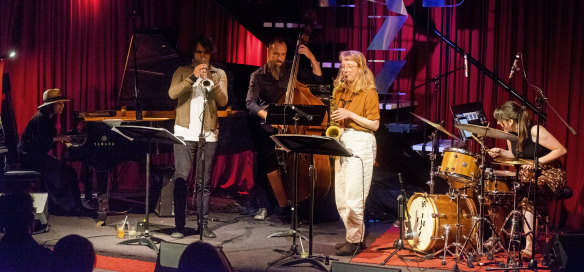
Sumire Kuribayashi, Niran Dasika, Sam Anning, Flora Carbo and Kyrie Anderson perform in Melbourne.Credit: Roger Mitchell
Here, too, the rhythm section moved in sympathy with the leaders’ energy – rarely cleaving to a strict pulse, but instead phrasing by feel as the music swelled and subsided, creating glades of quiet contemplation or dynamic crescendos of free-form adventure.
Saxophonist Flora Carbo also joined the ensemble for two numbers, sliding in graceful tandem with Dasika on Orison and augmenting the sweeping, soulful majesty of Here and Now.
The group closed with All Good Things – a serene and faintly melancholy piece where the players moved with such subtlety that the final, fading notes felt like a collective exhalation.
Reviewed by Jessica Nicholas
MUSIC
Noël! Noël! ★★★★
Australian Brandenburg Orchestra, Melbourne Recital Centre, December 17
This year’s edition of the Australian Brandenburg Orchestra’s annual Christmas concert was an impressive spectacle, the holiday mood being enhanced by festive stage lighting in the form of stylised Christmas trees designed by Trent Suidgeest. Musically, the slick, 80-minute presentation was an enjoyable tasting menu of seasonal treats, which never outwore its welcome and where the music largely spoke for itself.
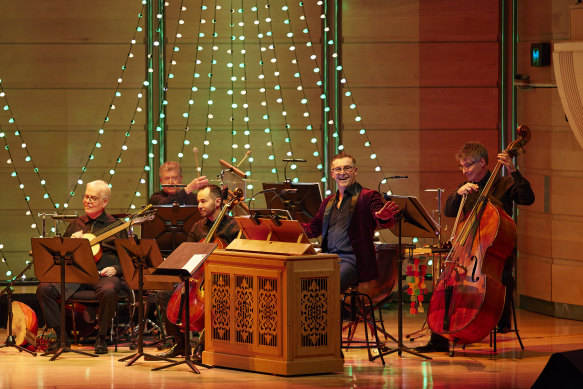
The Australian Brandenburg Orchestra and Brandenburg Choir perform one of their annual Noël! Noël! concerts in Sydney, with guest artist Marcus Corowa.Credit: Keith Saunders
In good form, the orchestra responded well to the irrepressible energy of conductor Paul Dyer, whether in the Sonata Sancti Caroli, a pastiche of music by Rittler and Biber, or in The Twelve Carols of Christmas, a humorous mash-up of carols across the centuries by Alex Palmer.
As usual, one of the highlights was the splendid clarity and vocal verve of the Brandenburg Choir, who gave effervescent joy to John Rutter’s arrangement of Deck the Hall and revelled in the baroque swagger Dyer brought to Hark! The Herald Angels Sing and O Come, All Ye Faithful. Unfazed by Dyer’s brisk tempos, they also brought admirable lightness to Rutter’s Handelian take on Joy to the World and two Christmas choruses from Messiah.
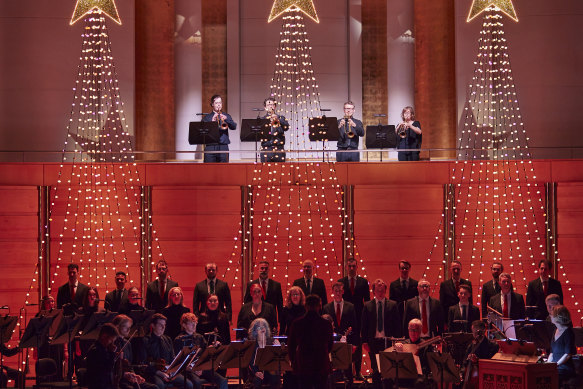
The Australian Brandenburg Orchestra and Brandenburg Choir perform one of their annual Noël! Noël! concerts in Sydney, with guest artist Marcus Corowa.Credit: Keith Saunders
Soprano Mia Robinson invested Esenvalds’ Only in Sleep with poignant reverie and delivered appropriate atmosphere to Enya’s May it Be. Amongst the other well-sung choral numbers were a shortened version of Biebl’s Ave Maria quirkily accompanied by sackbuts, and Silent Night sung in German, French and English.
First Nations singer Marcus Corowa radiated a genuine, easygoing warmth in his rendition of popular songs like Have Yourself a Merry Little Christmas and John Lennon’s Imagine, and demonstrated his own songwriting talents in Water & Air.
A large, appreciative audience affirmed the popularity of the eclectic programming, which happily this year did not stray too far from the early music the Brandenburg does so well.
Reviewed by Tony Way
OPERA
A Christmas Carol ★★★★
Victorian Opera, Palais Theatre, until December 17
Victorian Opera’s premiere production of A Christmas Carol shows us what a modern-day Ebenezer Scrooge would look like, if he just so happened to live in Melbourne.
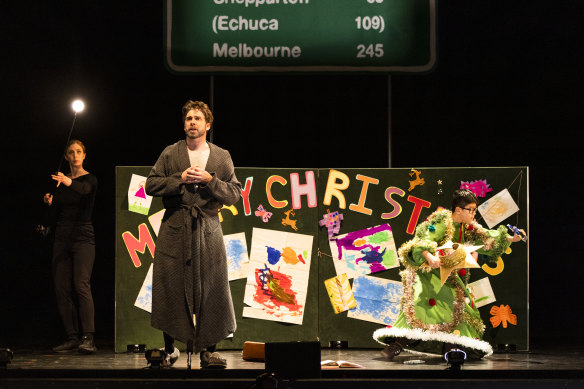
Nadine Dimitrievitch as the puppeteer, Samuel Dundas as Ebenezer Scrooge and Maxwell Chao-Hong as Child Scrooge in the Victorian Opera production of A Christmas Carol.Credit: Charlie Kinross
For those familiar with the original novella, the skeleton is much the same. The famously miserable and miserly Scrooge (Samuel Dundas) rebuffs carollers, rejects invitations from his family, and resents his employee for wanting to spend Christmas with his family. It takes a visit from three Christmas spirits and the ghost of his departed colleague Jacob Marley (Simon Meadows) to convince him to change his ways.
In 2022, however, Scrooge has a very specific list to bah humbug his way through. He hates the “woke”, the virtue signallers, the unions. He swats away a Big Issue seller and rejects the idea of donating to the medical industry saying that maybe it would be better if the population thinned a bit.
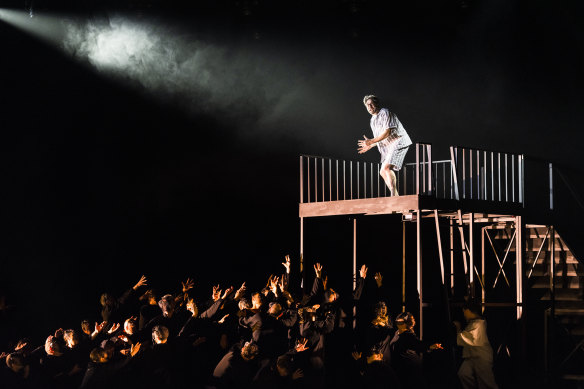
Samuel Dundas as Ebenezer Scrooge in Victorian Opera’s A Christmas Carol.Credit: Charlie Kinross
The strength of this operatic interpretation is how everything familiar is subverted, ever so slightly. Scrooge tucks himself into bed and his face is immediately lit up by his phone as he settles in for the infinite scroll. The sound of a phone alarm is rendered by different parts of the orchestra as he waits for his first spirit to arrive. Christmas carols are woven throughout, melting into Graeme Koehne’s original music. The aggressively wholesome Cratchit family storyline also bleeds into a number which, bluntly but affectingly, pleads for greater empathy and action on wider issues, including the refugee crisis.
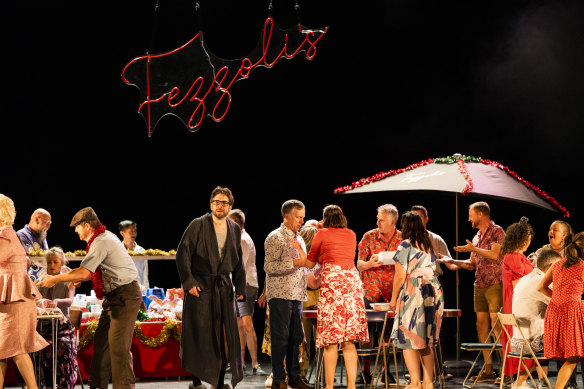
A scene from Victorian Opera’s premiere production, A Christmas Carol. Credit: Charlie Kinross
Marley’s visit to Scrooge is given extra resonance by having two evenly matched baritones in Dundas and Meadows. If you close your eyes, it’s difficult to tell who is singing, underscoring through more than words the very real threat of Scrooge suffering an identical fate.
Akansha Hungenahally was the stand-out, her clear and sweet voice embodying the joy and innocence Scrooge thought he had long left behind. Story-wise, however, having her sing the role of Scrooge’s beloved sister immediately before also appearing as his ex-fiance made for a few confusing moments.
Some sequences are a little longer than they need to be, and a light puppeteered by a cast member was at times distracting and – assumedly unintentionally – humorous. Ultimately, however, Victorian Opera’s production thrives by blending two types of familiarity – a setting audiences might recognise intimately, with a beloved story filled with hope.
Reviewed by Elizabeth Flux
DANCE
Pieces ★★★★
The Substation, Newport, until December 17
This is only the third edition of Pieces, an annual showcase of work by independent choreographers, but already it feels like an institution of many years standing in the Melbourne dance scene.
The evening’s first work, Melanie Lane’s Into the Woods, places itself in the long tradition of modern and contemporary dances about witchcraft and the persecution of people believed to be witches.
Lane moves with power and purpose in front of a computer-generated image of a medieval hut, while her costume billows around her like an ominous black cloud encircling her waist.
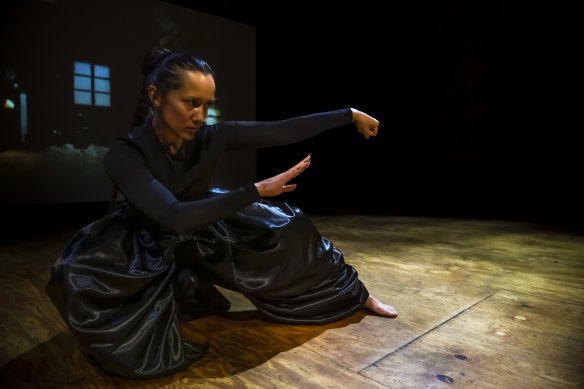
Melanie Lane performs a work about witchcraft.Credit: Gregory Lorenzutti
There’s an account of an execution, a recording of an eyeless woman reciting a poem by Victor Hugo and a duet with Sara Black. And somehow, as if by magic, it all coheres.
Rachael Wisby’s Roses, a meditation on 19th-century ballet, gives an impression of cut flowers left too long in the bowl: things that were once upright are now drooping, fading and decomposing.
Wisby wafts back and forth in a translucent gown, projecting mingled lassitude and distress. Meanwhile, her boots are airlifted to the safety of the rigging.
The piece concludes with Wisby narrating a sci-fi version of Giselle while drawing back all the curtains. It’s a crowded finale where either one or the other gesture would have been sufficient.
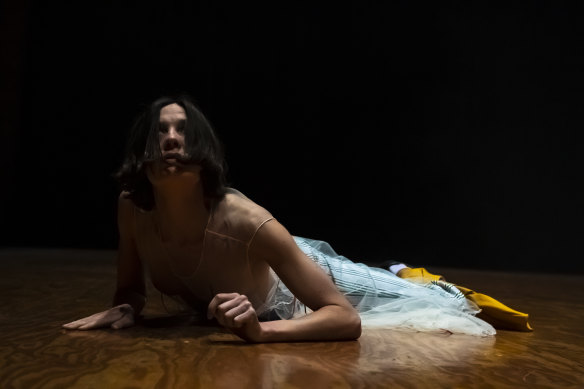
Rachael Wisby’s work, Roses, is a meditation on 19th-century ballet.Credit: Gregory Lorenzutti
The final work, and my highlight, is Amber McCartney’s Tiny Infinite Deaths, a tour de force translation from the natural world in which McCartney performs the dance of the maggot.
With its sleazy, retro-futuristic score by Makeda Zucco and an enchanting larva-like costume by Andrew Treloar, this portrait of a jiving juvenile grub is deliciously unsettling.
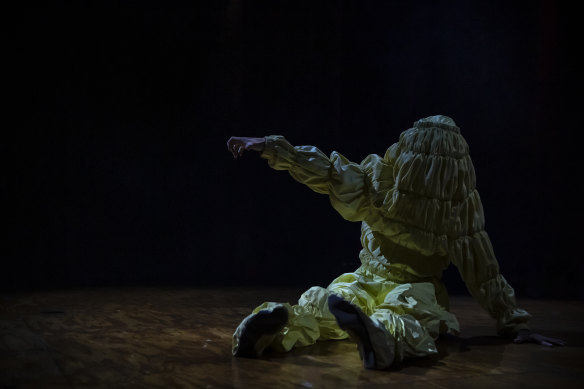
Amber McCartney performs the dance of the maggot in a tour de force production.Credit: Gregory Lorenzutti
Beginning with twitches and pulses, the grub graduates to strutting and twirling and sashaying. It grows into a character of fascinating mutability, forever on the cusp of a more permanent transformation.
Reviewed by Andrew Fuhrmann
MUSIC
Making Gravy ★★★★
Paul Kelly, Sidney Myer Music Bowl, December 9
To attend Paul Kelly’s annual Making Gravy concert at Christmastime is to attend church for many Melburnians – such is the atmosphere of reverence and camaraderie on this unseasonably chilly December evening.
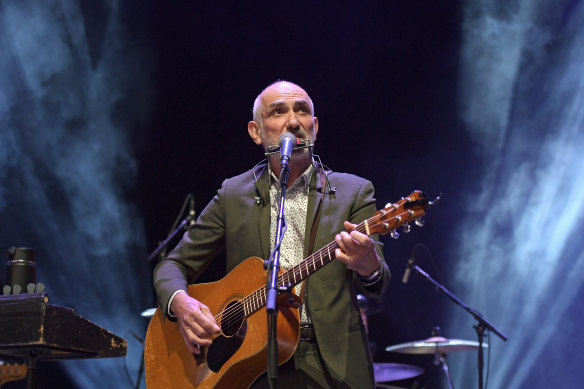
Paul Kelly’s “Making Gravy” concert at the Sidney Myer Music Bowl has become a summer tradition.Credit: Martin Philbey
Kelly is a master songwriter and storyteller, who on this night stands before hundreds of families to share his rock hymns and pay tribute to the Australian artists we have lost this year. The beauty of Kelly’s music has long been his talent to succinctly capture local memory and identity – there’s a sense that his fans are gathering to remember who they are and where they’ve been by singing the clear-eyed chorus of Leaps and Bounds, and the jaunty verses of Before Too Long.
Young, gutsy contemporaries Alex the Astronaut, The Beths, and Amyl and The Sniffers kick off the Making Gravy extravaganza this year.
A significant proportion of Kelly’s younger fans who may have shown up to support these acts are away at Meredith Music Festival this weekend, so they play to a modest, polite crowd.
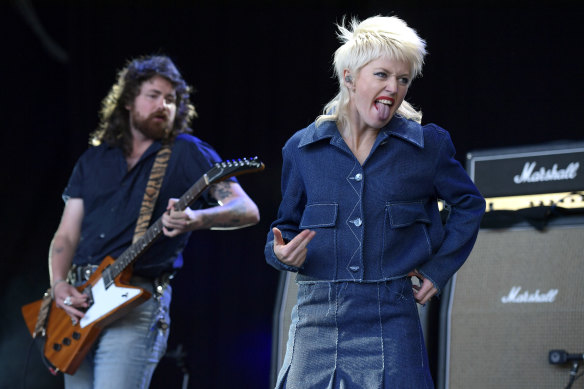
Amy Taylor from Amyl and the Sniffers.Credit: Martin Philbey
A solo, acoustic rendition of Maybe This Christmas opens Kelly’s set, his familiar, comforting voice and presence matching the crowd’s sleepy picnic rug set-up. It isn’t until his rollicking band kicks into gear that the audience is reminded of where they are and by nightfall, everyone is on their feet. Kelly has a contemplative, charming anecdote for every song – even his covers – and his two-hour performance sees friends coming and going on stage, both physically and in spirit.
Kelly fondly remembers his collaboration with the late Archie Roach on their song Rally Round The Drum, and Olivia Newton-John is commemorated with vocalist Jess Hitchcock singing Banks Of The Ohio. An awe-inspiring finale takes the form of Kelly’s 2017 song Rising Moon – co-written with William Harris Miller – heralding the brilliant full moon to reveal itself floating above the amphitheatre’s cover.
Reviewed by Jess Zanoni
MUSIC
King Gizzard and the Lizard Wizard ★★★★½
Palace Foreshore, St Kilda, December 10
A lengthy, hugely successful overseas touring schedule has meant hometown fans haven’t had many chances to catch King Gizzard and the Lizard in full flight recently.
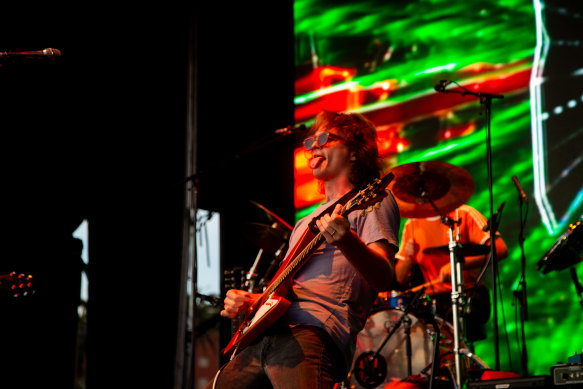
King Gizzard and the Lizard Wizard perform at the Palace Foreshore.Credit: Simoen van der Meent
All that changed on a balmy Saturday evening in St Kilda, when the seven-member band unleashed two-hours of expertly controlled mayhem, swerving from ferocious, guitar-fuelled rock to spontaneous, rumbling jazz grooves.
In between, singer and guitarist Stu Mackenzie found time to whip out his flute, multi-instrumentalist Ambrose Kenny-Smith jumped on saxophone and traded lead vocals with Mackenzie and fellow guitarist/keyboardist Joey Walker, while fans swayed along or simply stood spellbound in the setting sun.
Rarely seen these days at any rock concert, a thundering drum solo from Michael Cavanagh during Crumbling Castle helped build early momentum, before Planet B, from the 2019 album Infest the Rats’ Nest, pushed the show into heavy, psychedelic territory.
A flickering, hypnotic stream of fuzzy images pumped out constantly from the massive video screen behind the band, as Planet X, from new album Omnium Gatherum, took the energy to a whole new level of heavy.
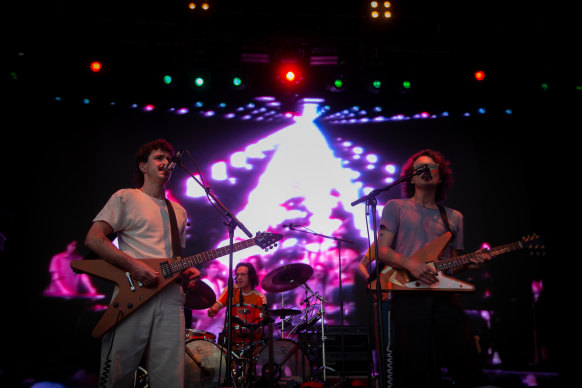
King Gizzard and the Lizard Wizard offer up two-hours of expertly controlled mayhem at the Palace Foreshore.Credit: Simoen van der Meent
In King Gizzard’s universe, Omnium Gatherum’s April release isn’t exactly new. The band released three albums in October, and played monster versions of Ice V and Iron Lung, both from the Ice, Death, Planets, Lungs, Mushrooms and Lava album, before dipping back into Omnium Gatherum for the far gentler, jazzier Ambergris.
“This song is about vaping,” Mackenzie said, before the group went all the way back to 2013, closing an epic show with Float Along – Fill Your Lungs.
Earlier, Melbourne five-piece rock band Civic brought their powerful twin guitar attack to the foreshore stage, and Stella Donelly’s summery vibes were a sweet counterpoint to the wildly eclectic barrage of sound and vision that lay ahead.
King Gizzard travel back overseas in March for another extensive European tour, and return to the United States in the middle of the year.
Reviewed by Martin Boulton
MUSIC
Ceremony of Carols ★★★★½
Australian Chamber Choir, Our Lady of Mt Carmel, Middle Park, December 11 (Livestream)
The Australian Chamber Choir’s final concert for 2022 was a beautifully constructed and inventive program of carols divided between Benjamin Britten in the first half and Renaissance settings of some of the same texts in the second. The result, as choir manager and member Elizabeth Anderson put it, was “a kind of infinity mirror” that casts new light on the music in both halves.
The ACC, led by Douglas Lawrence, is a virtuoso ensemble with a burgeoning international reputation garnered on several European tours as well as at home, and this performance was both impressive and satisfying.
Britten’s A Ceremony of Carols, for choir and solo harp, was composed at 29 while crossing the Atlantic in 1942, while he wrote his extraordinarily mature Hymn to the Virgin at 16. Neither could have been sung more attractively.
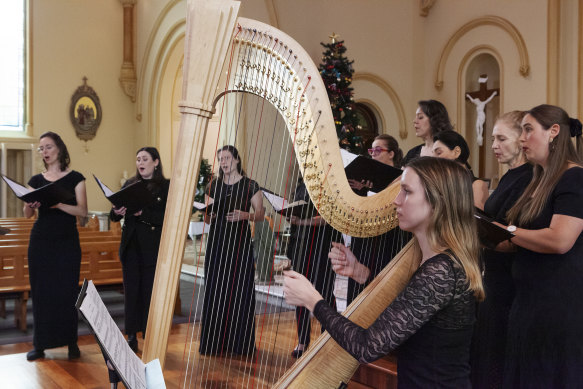
The Australian Chamber Choir performs Ceremony of Carols with harpist Melina van Leeuwen.Credit: Dianna Wells
The second half had several gems, especially Johannes Ockeghem’s famous 36-voice fugue Deo Gratias (arranged by Elizabeth Anderson), in which each of the 18 singers sang up to three entries, a considerable challenge and rather convoluted.
Other notable works included the Ukrainian Bell Carol (sung in Ukrainian; alas I cannot judge the diction) and a new ACC commission, The Carol of the Two Crows in which Alan Holley wittily set a new poem by Mark Tredinnick.
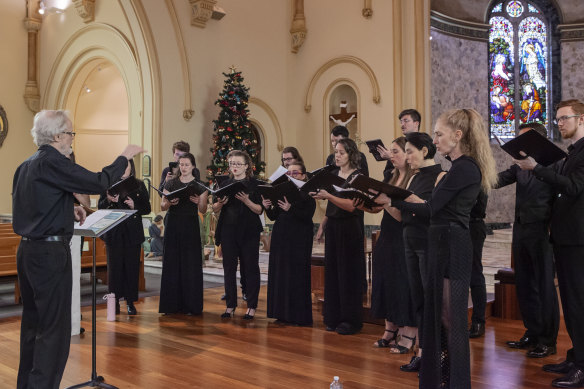
The Australian Chamber Choir performs Benjamin Britten’s Ceremony of Carols.Credit: Dianna Wells
All the works were sung tenderly, with consummate clarity, balance, dynamics and attention to detail.
I attended the concert by the ACC’s livestream service which, though at a slight cost to the intimacy and immediacy that only physical presence allows, compensated me with a very comfortable chair rather than a church pew, and plenty of legroom. The sound was excellent, the atmospheric acoustic well conveyed, and I could arrange my own encores on-screen – as well as the ACC’s encore, a repeat of the carol Angels We Have Heard on High with the audience joining the choir.
Reviewed by Barney Zwartz
MUSIC
Sir Andrew’s Messiah ★★★½
Melbourne Symphony Orchestra, Hamer Hall, December 10
A festive air surrounded this year’s outing of Handel’s Messiah by the Melbourne Symphony Orchestra. After several low-key presentations in recent years, the performance of Andrew Davis’ arrangement for a large orchestra and chorus, prepared some 12 years ago for the Toronto Symphony, put a different spin on the celebration of a cherished tradition.
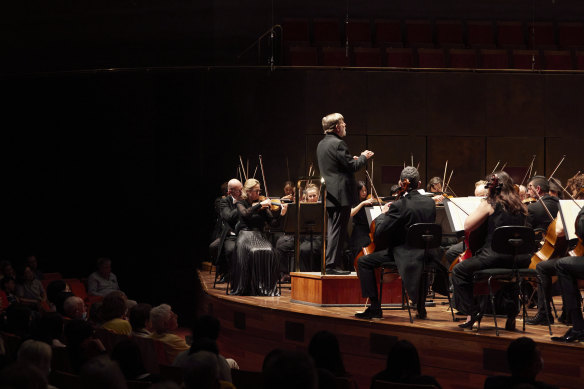
Sir Andrew Davis conducting the Melbourne Symphony Orchestra in December.Credit: Laura Manariti
It is perhaps a back-handed compliment to Handel that few classical works are as popular as Messiah, but few have attracted such a strong desire for others to “improve” his original. Davis stands in a long line, starting with no less a figure than Mozart and including conductor Eugene Goosens, who have reworked this masterpiece.
Davis’ detailed and sometimes fussy orchestration, with sleigh bells in the “Hallelujah” chorus, the harp deployed for “mystical” effect and the passing use of many other percussion instruments, was a mixed blessing.
Firstly, it meant that ensemble was more difficult to control, particularly in Part I, where different elements threatened to come adrift. More happily, the restrained scoring of most of the choruses allowed the vocal writing to come through, especially when the MSO Chorus was rather top-heavy, with sopranos and altos outweighing tenors and basses.
Fine solo singing ensured that much of the textual essence of the work was convincingly communicated.
Soprano Jacqueline Porter married radiant joy and pinpoint accuracy in Rejoice Greatly while tenor Andrew Goodwin gave Behold and See a plangent sincerity. Bass Christopher Richardson and mezzo-soprano Catherine Carby impressed with polished diction.
Although Davis maintained the festive atmosphere with plenty of energetic playing and astute pacing through the lengthy second half of the program, there was a sense of being overfed on novelties and of longing for the elegant economy of Handel’s original. After all, first and last, it will always be Handel’s Messiah.
Reviewed by Tony Way
JAZZ
Morgana + Sandy Evans and Andrea Keller ★★★★
Melbourne Women’s International Jazz Festival, The Jazzlab, December 10
When the Melbourne Women’s International Jazz Festival was first held in 1996 with the aim of encouraging women in jazz, Morgana – an all-female contemporary jazz quintet – had already been making waves for four years. The collective voice of these strongly individual players made a potent statement and had an enduring influence on the Australian jazz scene.
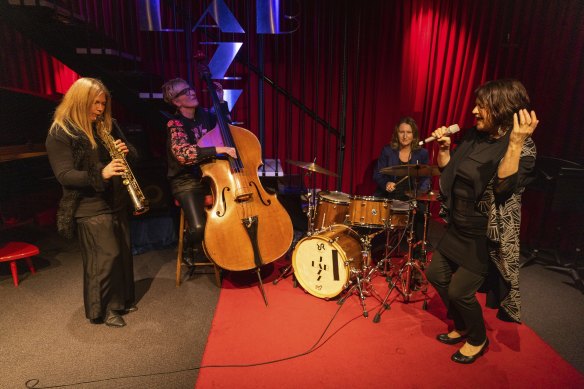
Morgana (from left): Fiona Burnett, Annette Yates, Sonja Horbelt and Lisa Young.Credit: Paul Jeffers
Two decades after disbanding, Morgana has now reunited for a handful of shows to mark the 30th anniversary of their formation. Yet their performance at this year’s MWIJF was far from an exercise in pure nostalgia. While the four original band members – and new member Andrea Keller – clearly revelled in one another’s company as they reconnected with old friends and familiar repertoire, the music sounded as fresh as if it had been newly penned.
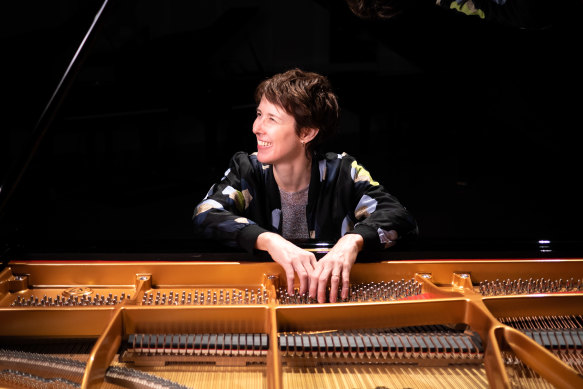
Andrea Keller is the newest member of legendary local jazz band Morgana.Credit: Jamil Nawaz
Lisa Young’s voice is still marvellously agile and expressive, skipping from song lyrics to improvised scat or konnakol (Indian vocal percussion). Fiona Burnett’s soprano saxophone wrapped itself around graceful melodies and leapt across intervals in fleet arpeggios. Annette Yates’ supple bass and Sonja Horbelt’s drums provided the band’s rhythmic heartbeat (and a special mention here for the indefatigable Horbelt, who – as MWIJF chair, curator and programmer – is also the heartbeat of the festival itself). At the piano, Keller matched the mood of each piece with perfectly judged accompaniment, from laid-back swagger to urgent propulsion.
Keller also appeared earlier in the evening in a duo set with Sydney saxophonist Sandy Evans. This superb pairing brought together two hugely influential artists whose ego-less communion was on show from the opening bars of Flicker #2, as Evans launched into an arresting solo that seemed to emanate from the core of her being. The duo premiered several new tunes, including the subtly ingeniously Secret 64 and For Archie, a tender tribute to Archie Roach that was both uplifting and deeply soulful.
Reviewed by Jessica Nicholas
A cultural guide to going out and loving your city. Sign up to our Culture Fix newsletter here.
clarification
An earlier version of this article did not list the co-writer of the song Rising Moon, William Harris Miller.